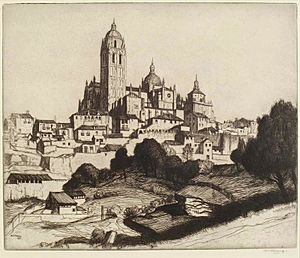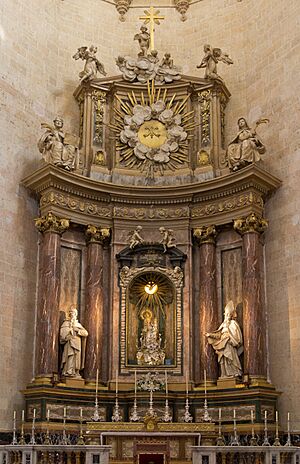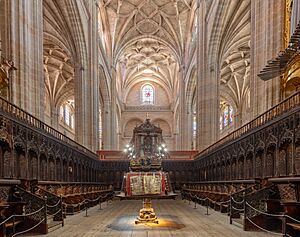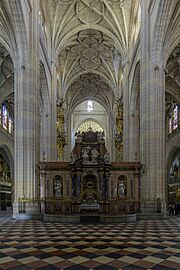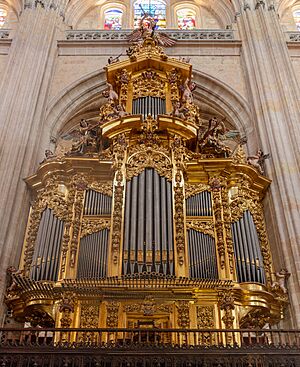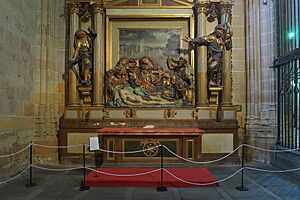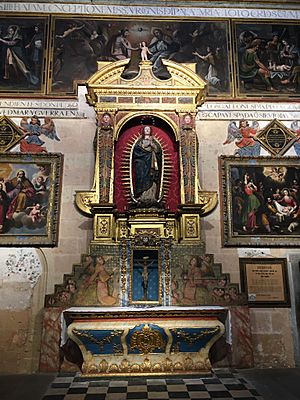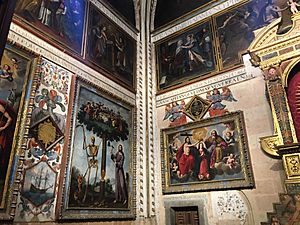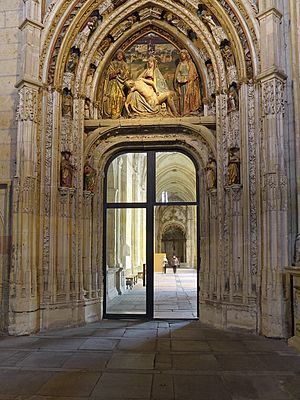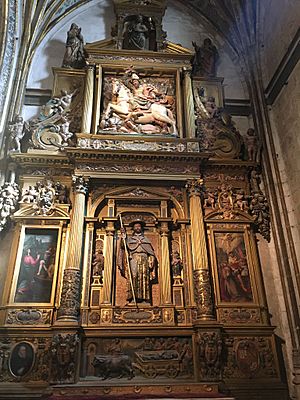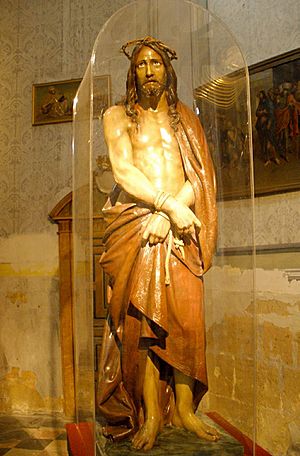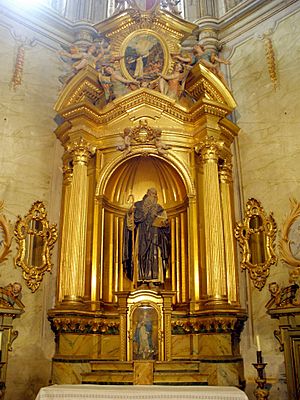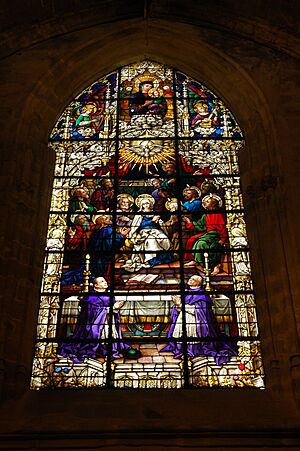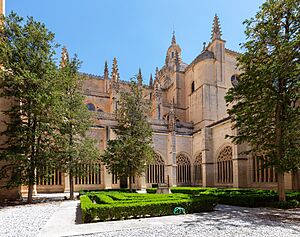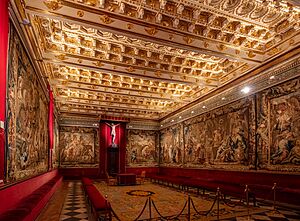Segovia Cathedral facts for kids
Quick facts for kids Segovia Cathedral |
|
|---|---|
| Cathedral of Our Lady of the Assumption and of Saint Fructus | |
| Catedral de Nuestra Señora de la Asunción y de San Frutos | |
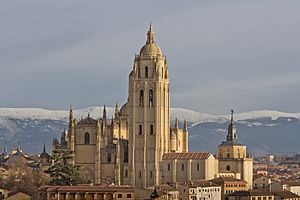
The west side and bell tower of the cathedral, seen from the Alcázar.
|
|
| 40°57′00″N 4°07′31″W / 40.95°N 4.12528°W | |
| Location | Segovia |
| Country | Spain |
| Denomination | Catholic |
| History | |
| Status | Cathedral |
| Dedication | Assumption of the Virgin Mary and Saint Fructus |
| Dedicated | 16 July 1768 |
| Architecture | |
| Architect(s) | Juan Gil de Hontañón (first) |
| Style | Late Gothic |
| Groundbreaking | 8 June 1525 |
| Specifications | |
| Tower height | 88 m (288 ft 9 in) |
| Administration | |
| Metropolis | Valladolid |
| Diocese | Segovia (since 6th Century) |
The Cathedral of Our Lady of the Assumption and of Saint Fructus, also known as Segovia Cathedral, is a large Roman Catholic church in the city of Segovia, Spain. It is dedicated to the Assumption of the Virgin Mary and to Saint Fructus, a local saint.
The cathedral is famous for its beautiful Gothic style. It was one of the last great Gothic cathedrals built in Europe. Because of its size and beauty, it is often called "The Lady of Cathedrals." It was officially dedicated in 1768.
Contents
History of the Cathedral
The cathedral you see today is not the first one built in Segovia. The original cathedral was located next to the Alcázar, a famous castle. It was destroyed in the 1520s during a conflict called the Revolt of the Comuneros.
During the revolt, the people of Segovia were unhappy with their leaders. The city was blockaded, and fighters used the old cathedral as a base to attack the castle. After months of fighting, the cathedral was left in ruins.
King Charles V ordered a new cathedral to be built. He wanted it in a different spot to keep it safe from future conflicts. The new location was on top of a convent and part of the old Jewish quarter.
Building a Masterpiece
The first stone of the new cathedral was laid on June 8, 1525. The main architect was Juan Gil de Hontañón. To save money, parts of the old ruined cathedral, like its cloister (a covered walkway), were moved and used in the new building.
The construction took a very long time and was done in three main stages. It was finally completed in 1685. The tower originally had a wooden spire, but after it was struck by lightning in 1614, it was replaced with the stone one that stands today. The cathedral was officially consecrated, or blessed for religious use, on July 16, 1768.
Inside the Cathedral
The inside of the cathedral is a stunning example of late Gothic style. It has three tall aisles, called naves, and beautiful, detailed windows with colorful stained glass. The stone vaults of the ceiling soar 30 meters (98 feet) high. The whole building is 109 meters (358 feet) long and 50 meters (164 feet) wide.
The huge dome over the center of the church was finished in the 17th century. The bell tower is nearly 90 meters (295 feet) tall.
Main Chapel and Altar
The main altar was built between 1768 and 1775, designed by the architect Francisco Sabatini. It is made of different colored marbles and shiny bronze.
In the center is a statue of the Virgin of Peace from the 13th century. It is covered in silver. On either side are large marble statues of two saints, Saint Fructus and Saint Hierotheos. The beautiful metal grilles that close off the altar are decorated with coats of arms and lilies.
The Choir
The choir is the area where the clergy and singers sit during services. Its beautifully carved wooden stalls were saved from the old cathedral and installed here in 1558. The style is Flamboyant Gothic, which is known for its flame-like patterns. There are special seats reserved for the king and queen.
The Retrochoir
The retrochoir is the space behind the choir. Its altarpiece was brought from the Palace of Riofrío. In the center is a silver urn from 1633 that holds the relics (sacred objects) of Saint Fructus. The altarpiece is decorated with statues of Saint Peter, Saint Paul, and other figures.
The Organs
The cathedral has two magnificent organs. The original organs from the old cathedral were moved here in 1559. The two organs you see today were built later. The first was finished in 1702, and the second was built in 1769 after a large donation from the bishop of Segovia.
Chapels of the Cathedral
The cathedral has many small chapels along its sides and around the back of the altar. Each one is a work of art with its own unique altarpieces, sculptures, and decorations.
Chapels on the North Side
- Chapel of the Pietà: This chapel features a famous sculpture group of the Burial of Christ, created by the artist Juan de Juni in 1571. The amazing grille that closes the chapel was made in 1515 for the old cathedral.
- Chapel of the Conception: Located at the foot of the cathedral, this chapel has a beautiful altarpiece of the Immaculate Conception. It also contains a collection of paintings by the artist Ignacio de Ries from 1653.
Chapels on the South Side
- Chapel of Saint James the Great: This was the first chapel given to a private citizen. Its altarpiece from 1595, dedicated to the apostle Saint James, is a masterpiece by the sculptor Pedro de Bolduque. Below the chapel is a crypt, or underground room, that was designed as a family tomb.
- Chapel of the Recumbent Christ: This chapel is famous for its sculpture of the Recumbent Christ (Christ lying down after his death). It was carved by the great artist Gregorio Fernández in the 17th century. The sculpture is known for being very realistic and dramatic. It is carried through the streets of Segovia in a procession on Good Friday.
Chapels of the Ambulatory
The ambulatory is the curved aisle behind the main altar. It also has several chapels.
- Chapel of Saint Fructus: This chapel is dedicated to Saint Fructus and his brother and sister, Saint Valentín and Saint Engracia. It has three altarpieces, one for each of them.
- Chapel of Saint Ildefonsus: This chapel has a beautiful altarpiece showing the Virgin Mary giving a special garment to Saint Ildefonsus. It also contains a powerful sculpture of Ecce Homo, which shows Christ after he was captured.
Stained Glass Windows
The cathedral's 65 stained glass windows are one of its greatest treasures. They were made in three different periods.
The oldest windows are from the 16th century and are considered some of the best examples of Renaissance stained glass in Europe. Another large set of 33 windows was made in the 17th century. The newest windows were added in 1916. In 2010, a project began to restore all the windows to their original glory.
Other Important Rooms
Cloister
The cloister is a beautiful covered walkway around a garden. It is special because it was carefully moved, stone by stone, from the old cathedral that was destroyed. It is the only major part of the old cathedral that still exists today.
Chapter Hall
The Chapter Hall was the meeting room for the cathedral's leaders. Today, it is decorated with a stunning collection of eleven tapestries made in Brussels. These tapestries tell the story of Queen Zenobia of Palmyra. The room also has a beautiful gold and white coffered ceiling from the late 16th century.
Paint Museum
This room displays 42 religious paintings by Spanish and Flemish artists. One of the most important pieces is the Triptych of the Descent from the Cross by Ambrosius Benson. A triptych is a painting made of three panels that are hinged together.
Room of Saint Catherine
This room, which used to be a chapel, now serves as a museum. It displays beautiful tapestries, relics, and the tomb of Prince Pedro, the infant son of King Henry II of Castile. The prince tragically died as a baby. In 2020, researchers confirmed that small bones found in the tomb belonged to the infant prince.
See also
 In Spanish: Catedral de Segovia para niños
In Spanish: Catedral de Segovia para niños
- Roman Catholic Diocese of Segovia
- List of cathedrals in Spain


